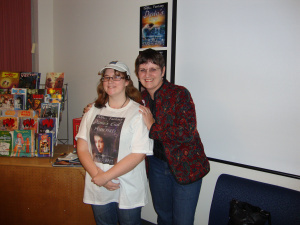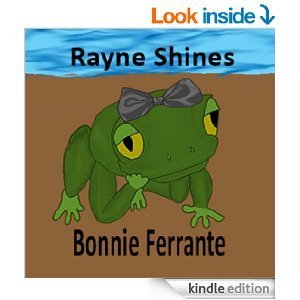Bonnie Ferrante's Blog, page 100
April 19, 2014
Happy Easter Everyone!
McBratney, Sam – Guess How Much I Love You – Book Review
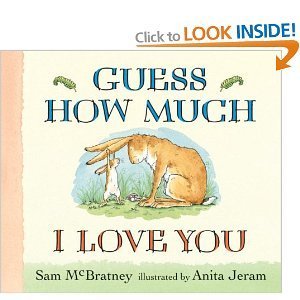
This is a lovely, gentle story about a bed time conversation between Little Nutbrown Hare and his father, Big Nutbrown Hare. It was nice to encounter a story where the father was putting the child to bed and expressing how much he loved him.
The story begins when the little hair asks his father to “Guess how much I love you.” So begins a sweet and humorous competition. When the little hair stretches out his arms to show how much he loves his father, the father stretches his arms out even further. Little Nutbrown Hare reaches as high as he can with his hands and then his feet. He jumps as high as he can hop, and on and on it goes. At the end, the little hare says “I love you right up to the moon.” Father concedes the contest. But after the little hair snuggles into sleep, father whispers, “I love you rate up to the moon – and back.”
The message that their love for each other is so deep he can never be expressed in words comes through loud and clear. The friendly competition shows the playful affection between parent and child. This is the perfect gift for a father to buy his child.
The illustrations by Anita Jeram are soft and endearing, reminiscent of Beatrix Potter’s. She makes excellent use of white space. Pictures seem to be a combination of pen and ink and watercolor. The expressive movements of the hares make the words come alive.
Highly recommended.


April 18, 2014
Free Picture Book Reviews
If you have a published picture book, I will review it for free. I prefer a paperback copy. I can connect better with the story and how it would feel reading it to a child. Otherwise, I will take mobi or pdf. Paperback copies will always go to the head of the line and will be reviewed before digital books no matter how long I’ve had them.The review will go up on my blog only for two weeks, then I will post it on Goodreads, Amazon (if there), Shelfari, Barnes and Noble (if there), Librarything, and put a connection on my facebook page. You may send a 150 word bio with the book. Please also provide a link to the buy page and a link to a cover image. To see how I review, check out the ones I’ve done by clicking on Categories and choosing Book Reviews.
If the book review is one or two stars, you may ask me not to post it elsewhere, but it will remain on my blog. I am fair but honest. I use respectful words and give helpful criticism to help authors improve their work.
In return for taking the time and effort to review your book, I ask that you show respect for my work as well. It is important for authors to maintain their dignity and professionalism. You must agree not to post vindictive remarks against me or my review, to vote down any of my books on Amazon, or to rally your friends to give bad reviews. The more often authors engage in this behaviour, the less readers are willing to post reviews. It is for our mutual benefit to keep readers reviewing and reading reviews.
Email me at b.ferrante at tbaytel dot net.


April 16, 2014
Brand New Blog
Hi Everyone,
I’ve just moved to wordpress from blogger. I’ve narrowed the focus of my blog and am figuring out how to use the options available. I’m excited by the robust nature of wordpress. Please be patient while I muck about with the settings.
I am still accepting picture books for review.
Ciao,
Bonnie


April 15, 2014
Voltera de Saulnier, Gia – Journey to Jazzland – Book Review

Gia Voltera de Saulnier struggles with a problem, common to beginning writers – editing. Whether this piece was a picture book or an adult book, I would give it the same advice. Being succinct is especially important in a children’s picture book. Publishers recommend 50 to 600 words for a 32 page picture book. A very few exceptional books may broach 1000 words. Over a thousand is cumbersome. Journey to Jazzland is over 1700 words. This is unnecessary and really bogs down what could have been a good children’s picture book about music.
I’ve copied the first few pages of Journey into Jazzland and, in brackets, I will point out where it could’ve been trimmed. This section has 345 words.
Journey to Jazzland
One day during an orchestra (picture shows it’s an orchestra )rehearsal, (We know it’s one day. Don’t tell us.) Windy Flute was playing (complicated passive verb tense) a piece of music and her mind started to wander. Over and over, she had practiced the piece and played the piece. (Overly repetitive) Feeling bored, she felt that she wanted to be a little different. (Saying basically the same thing twice.) Then something special happened. (Don’t tell us something’s going to happen. Just make it happen. ) She began to hear notes that weren’t on the page of sheet music on her stand!
When she started playing what she heard, Windy realized (Realized is almost always an unnecessary word.) These new notes made her feel better. (Overly wordy )The harmonies and the melodies were the same, but the music moved differently. Before she could figure things out, she was interrupted by a stern voice. (Repetitive)
“Excuse me, Ms. Flute, (this is enough. You don’t need to tell us an interruption is coming.) Do you mind playing with the rest of us? Where do you think you are — Jazzland?” said Mr. Conductor, scowling down at her. (Description unnecessary. We get the idea from what he’s saying. It can also be shown in the picture.)
After the rehearsal, Mr. Conductor gave Windy a severe look and stomped off the stage. (Unnecessary for the story)
Windy turned to her friends in the woodwind section. “What’s Jazzland?” she asked. (Simplify )She was still thinking about the good feelings she got from playing different notes. (Unnecessary)
“It’s a myth,” said Mr. Bassoon.
“That’s right,” said Mr. Oboe, “It’s a legend. It doesn’t really exist.”
“I think it exists,” said Spitz Trumpet. (If you’re saying something, we know you think it.)
“Really, you do? What is it?” Windy was so excited; she almost knocked over her music stand.
“I think Jazzland is a place where instruments in a group have the freedom to play their own music.” Spitz said with a big smile. (Tighten these five sentences, they ramble.)
“That sounds great!” Windy said to Spitz. “I wonder how I can get there!”
“Hey, are you really going to find this place?” asked Spitz.
“Yes, I want to go now since rehearsal is over,”(You already said rehearsal was over.) she said. “I want to see if I can find it.”
“Well, in that case, I’m coming too.” Spitz said, as he put his sheet music away. “And if the stories are true, we’re going to need some more friends to help us get there!” (Tighten these four sentences.)
Windy smiled at her friend, who was brassier than she was. (Awkward)
Then Windy and Spitz set out on their journey to find Jazzland. (Shorten)
In the rest of the book, the author takes space to describe the environment. The reader should be able to see the environment. She has a habit of over explaining. After a strong edit, picture book author should then put the picture and words together and examine where else the text can be cut. If your word count is too high, cut everything that is shown in the picture. As well, all writers should avoid using passive verbs like “was”. They tend to involve slow-paced, convoluted language. Choose powerful verbs. A picture book is a lot like poetry. More often, less is better. Never use a dozen weak words when you can use five strong ones.
Let’s see what happens with my first edit.
During a rehearsal, Windy Flute’s mind wandered as she played. She was bored playing the same music over and over so she played notes that weren’t on her sheet music. The harmonies and the melodies were the same, but the music moved differently.
“Ms. Flute, Where do you think you are — Jazzland?” demanded Mr. Conductor.
After rehearsal, Windy turned to her friends in the woodwind section. “What’s Jazzland?”
“It’s a myth,” said Mr. Bassoon.
“It exists,” said Spitz Trumpet. “In Jazzland, instruments are free to play their own music.”
“I’m going to go there,” said Windy.
“I’m coming too.” Spitz said, as he put his sheet music away. “And if the stories are true, we’re going to need some more friends to help us get there!”
Windy smiled at her brassy friend as they set out for Jazzland.
Obviously, this is not yet at a publishable stage. But you can see from a quick ten minute edit that the word count in this section has gone from 345 to 138. By going through the rest of the picture book, it would be easy to drop the word count by 60% and, in doing so, improve the pace of the story. The book would drop from 1700 words to well under 1000.
Then I would go back and compare the picture to each page of words seeing what else could be trimmed, improved, and enlivened.
The story itself is clever and the illustrations by Emily Zieroth are delightful. With a few strong edits, this book could make a useful addition to a classroom library. It would be a charming introduction to jazz music. Gia Volterra de Saulnier knows how pieces of the orchestra work together to create a full sound. I sincerely hope that she continues to write but solicits more feedback on her work before publishing. Unfortunately, at this time I cannot recommend this book.
I was given a free ebook copy of Journey to Jazzland to review.


Chance to win a free book
April 13, 2014
Submit Your Unpublished Children’s Book for Feedback
Once a week, I will critique an unpublished piece of writing for children, short story, novel, or picture book. I was a teacher-librarian for 10 years and an elementary school teacher for 23. I have always had a passion for children’s books and, after early retirement, finally have the time to write my own. I believe examining the work of others, even if it is not polished, can be a learning experience for me as well as of benefit to the writer. I will give a maximum of three suggestions for improvement.
Here are the guidelines for this opportunity. I may tweak them as I go along, but for now:
Submit one unpublished picture book or the first five pages of a short story or novel for children.
One piece of work will be selected per week for analysis on my blog.
Submission does not guarantee your work will be selected.
You must be willing to have selections from your work cited on my blog.
This will be a criticism, not an ego boost. I will give a maximum of three suggestions. If you’re looking for a pat on the back, don’t submit. If you’re looking for helpful, honest feedback, this is for you. You must be willing to accept my responses with grace. Do not write back to me defending your work or attacking me. If you do, I may decide to publish your unprofessional response for the world to see. (My criticism is constructive. I am not mean. This is to be an engagement of mutual respect.)
Take your time. I will only respond to your work once. Make sure it is the best piece of writing you can do before submitting.


April 12, 2014
Claverie, Jean – The Three Little Pigs – Book Review
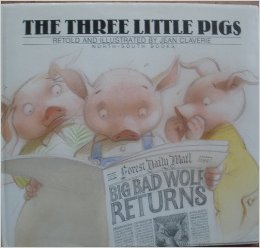
One thing I’ve noticed is that fewer children know the original fairy tales. Some are exposed to fractured fairytales and spoofs before they have even come in contact with the original. Even though these stories are old, they are still a big part of our cultural reference when it comes to literature. Probably the most well-known classic is The Three Little Pigs.
The version retold and illustrated by Jean Claverie, translated and adapted by Elizabeth D. Crawford has a lot to offer. It begins, “Once upon a time there were three little pigs. They loved one another very much, although each was very different from the other.” What a lovely way to teach acceptance of differences.
The illustrations are in soft pastel and pencil. They have a warm, gentle quality. Each pig’s character comes through beautifully. The first appearance of the big bad wolf is chilling. In an interesting twist, the Wolf says, “who dares to build houses on my land?”
The writing is vivid and rich, “Ha, two tender morsels at once!”
Neither the pigs nor the wolf meet their final demise in this version. At the end, the brick house is expanded so that the three little pigs can live together and also bring their mother. The story ends with the inverse of its beginning. On the first page, mother and the three pigs are crying as they hug goodbye. On the last page, mother and the three pigs are hugging and smiling as they say hello.
Some versions of The Three Little Pigs can be quite frightening but this one manages to arouse our concern for the pigs without becoming overly frightening. The wolf is genuinely villainous, but yet we have the feeling he also should be accepted for his differences.
This is a suspenseful but warm and gentle version of a timeless classic, suitable for even the youngest reader.


April 11, 2014
Stewig, John Warren Illustrated by Marco Tomes – Stone Soup – Book Review
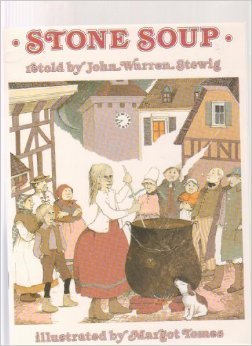
Stone Soup retold by John Warren Stewig, illustrated by Marco Tomes is a version of the traditional story. In the more familiar edition of capstone Soup, two soldiers enter a village and dupe the locals into creating a feast by proposing to make soup from the stone.
I was delighted to find a version where, instead of two soldiers, a young girl named Grethel is the protagonist. Because she and her mother are no longer able to make a living from their farm, she has set out to find a way to help them in their misfortune.
Unfortunately, although we care for the characters is the premise was engaging, I don’t feel it holds together as well as the original version. The two soldiers are trying to make their way home and starving along the way. Only stop at the village and convince people to participate in the creation of stone soup, they are only attempting to survive by so that they may continue their journey. The reader does not feel badly for the villagers because they have more than they admit share. The soldiers, one assumes, have been risking their lives in defence of their country. The least they deserve is a single meal.
Grethel however, brings a stone home in order to use it as a solution to her mother’s difficulties. One wonders how many times she plans to dupe the people in nearby villages, how long it will take them to catch on, and what the repercussion of that will be. The reasons the villagers originally give for not being able to feed Grethel seem legitimate, selling extra food by winter close for the children, or helping a brother’s family that had fallen on hard times.
In the original version, the reader assumes that once the soldiers return home they will take up whatever trade they had before the war and be able to support their families. In this version, there is no real solution to Grethel and her mother’s poverty. It seems that her long-term plan is to trick others and feeding them. This ending is not nearly as satisfying as the original.
The illustrations are quite similar to other versions I’ve seen. The black ink outlines and softly coloured pictures don’t offer anything new, except for the fact that, for once, the heroine is plain and simple. I would recommend looking for a more traditional version of this great story, Stone Soup.


April 10, 2014
You Only Get One Chance to Make a First Impression
I’ve used the comment, “You only get one chance to make a first impression,” to try to make self published right writers realize they shouldn’t expect their books to be edited by readers. I’ve tried to be supportive of other self published writers but unfortunately, and I don’t mean to sound like I’m the great expert, the majority of the writing was quite poor. When I offered to give suggestions on how to improve their writing, they weren’t interested. They are all too busy trying to promote mediocre or poor writing. It’s frustrating because it floods the market with junk and readers get turned off self published books. I myself got on board with the free downloads at Amazon only to erase 90% of them by page 5.
I was a grade school teacher for 33 years and have worked with children in various volunteer capacities throughout my life. I’m a mother and grandmother and have degrees in English and Primary-Junior-Intermediate education. During those 33 years, I was a teacher librarian for 10. Children’s books have been my life.
I respect how difficult it is to write quality picture book. I draw a parallel to poetry; it may be short but every word has to pack a punch. I offered to critique children’s writing for free on my blog, an offer that I personally would jump at, and had no takers.
Why do people assume that writing is easy? Why do writers assume they need no special training or feedback (other than from family and friends) in order to produce a quality children’s book? I would love to be part of a support group for children’s self published writers, but without a gatekeeper it can be very detrimental to your career to link yourself with people who don’t put in the necessary work. I even read a post by someone who did NaNoWriMo [wrote the first draft of a novel in the month of November] and then published it in the middle of December!
I’ve had numerous short pieces published the traditional way and several books published by a small press that went out of business. This may have given me an advantage in that I’ve had to meet certain standards with my writing, learn to accept criticism, and learn to work with an editor. It has motivated me to take courses, listen to podcasts, watch videos, attend workshops, participate in online classes, and read every decent book on writing I could find. This should be the norm for anyone wanting excellence in their work but, sadly, it seems not to be, especially in the area of writing for children.






